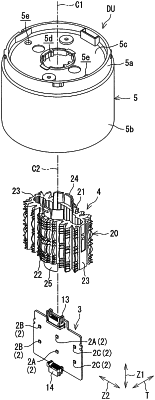| CPC F21K 9/66 (2016.08) [F21K 9/61 (2016.08); F21K 9/69 (2016.08); G02B 3/0037 (2013.01); F21W 2111/00 (2013.01)] | 11 Claims |

|
1. An indicator light that radially emits light away from a central axis toward a periphery of the central axis,
the indicator light comprising:
a support member including a disposition surface parallel to the central axis;
a light source including a central LED and a pair of side LEDs ;
a lens including a central lens portion and a pair of side lens portions; and
a cylindrical or a partially cylindrical translucent globe that surrounds the support member and the lens and that centers on the central axis; wherein
the central LED is disposed on a reference normal line that is a normal line with respect to the disposition surface in the disposition surface and that extends through the central axis;
the central LED includes an optical axis perpendicular to the disposition surface;
the pair of side LEDs are disposed on both sides between which the central LED is interposed at mutually equal distances from the central LED in an intersection portion between an orthogonal flat surface that includes the reference normal line and that is perpendicular to the central axis and the disposition surface;
the pair of side LEDs include an optical axis perpendicular to the disposition surface;
the central lens portion allows light from the central LED to be made incident and emits light into a central radiation angle range that is a radiation angle range determined by a central angle centering on the central axis and that centers on a central light-emission reference line along the reference normal line;
the pair of side lens portions include side incidence surfaces, respectively, on which radiation light from the corresponding side LED is made incident and emit light into a pair of side radiation angle ranges, respectively, containing a pair of side light-emission reference lines, respectively, that are inclined mutually opposite directions at an inclined angle of 60° with respect to the central light-emission reference line on the orthogonal flat surface;
the central lens portion includes a central light incidence portion having a central incidence surface on which light from the central LED is made incident and a plurality of central light guiding portions that branch from the central light incidence portion in a shape of branches and that extend toward a side of the globe in the central radiation angle range, and
each of the central light guiding portions includes a central emission end portion having a central emission surface that emits light to the side of the globe in the central radiation angle range, and
in each of the central light guiding portions, light that has been refracted and has been made incident from a corresponding incidence region of the central incidence surface onto the corresponding central emission surface is refracted and emitted from the corresponding central emission surface toward a corresponding region of the central radiation angle range.
|